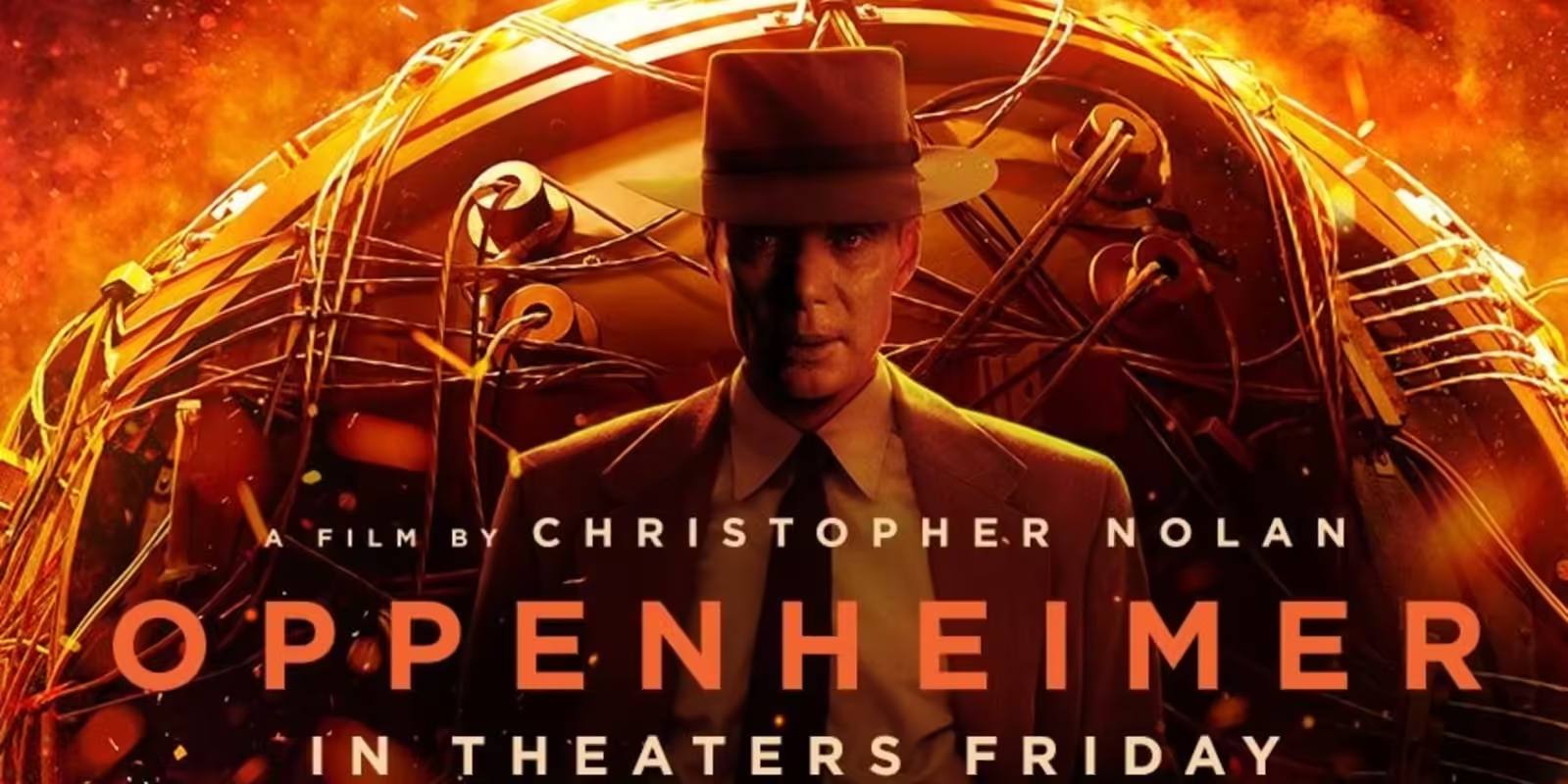“Oppenheimer,” directed by Christopher Nolan, is a highly anticipated biographical drama set to release in 2025. This film delves into the life of J. Robert Oppenheimer, portrayed by Cillian Murphy, showcasing his pivotal role in the development of the atomic bomb during World War II. With its blend of historical drama and intense character exploration, “Oppenheimer” promises to be a thought-provoking journey into the complexities of scientific discovery and moral dilemmas.
“Oppenheimer” follows the life of J. Robert Oppenheimer, a brilliant physicist who is recruited by the United States government to lead the top-secret Manhattan Project during World War II. The film explores Oppenheimer’s journey from a theoretical physicist to the director of the Los Alamos Laboratory, where he and his team race against time to develop the first atomic bomb. Amidst the scientific challenges and ethical dilemmas, Oppenheimer grapples with the implications of his work and its potential to alter the course of history. The plot unfolds against the backdrop of wartime urgency, political tensions, and personal sacrifices, culminating in the monumental Trinity test and the subsequent use of atomic weapons in Japan.
Throughout the film, Oppenheimer’s complex personality and moral struggles are portrayed, reflecting the broader themes of scientific responsibility and the consequences of technological advancement. His relationships with colleagues, including physicists like Richard Feynman and Enrico Fermi, as well as government officials, provide additional depth to the narrative. “Oppenheimer” ultimately examines the human cost of scientific innovation and the enduring impact of one man’s decisions on the modern world.
“Now I am become Death, the destroyer of worlds.”
This quote is taken from the Bhagavad Gita, a 700-verse Hindu scripture that discusses the moral and philosophical dilemmas faced by a warrior prince. In the film, Oppenheimer reflects on this line after the successful Trinity test, the first detonation of an atomic bomb on July 16, 1945. The moment is portrayed as one of intense introspection for Oppenheimer, as he contemplates the destructive power he has helped to create. The quote signifies his realization of the bomb’s devastating potential and his personal struggle with the moral implications of his scientific achievement. This line is often used to underscore the profound psychological impact and sense of responsibility that Oppenheimer felt.
| Title | Oppenheimer |
|---|---|
| Director | Christopher Nolan |
| Genre | Biographical drama, Historical thriller |
| Release Date | July 21, 2023 |
| Cast |
|
| Writers | Christopher Nolan, Kai Bird, Martin Sherwin |
| Produced By |
|
| Music by | Ludwig Göransson |
| Cinematography by | Hoyte Van Hoytema (director of photography) |
| Editing by | Jennifer Lame |
| Casting By | John Papsidera |
| Production Design by | Ruth De Jong |
| Art Direction by |
|
| IMDB Rating |

|
| Rotten Tomato Rating |

|
| Metacritic |

|
| Themes | Nuclear weapons, Scientific ethics, Cold War, Politics, Morality |
| Production Details | Shot on IMAX 65mm and 65mm large-format film |
| Production House |
|
| Where to Watch | Youtube, Apple TV, Amazon Prime Video, Google Play, Vudu, Peacock streaming service |
| Distributed By | Universal Pictures |
| Adapted By | Christopher Nolan, based on the book “American Prometheus” by Kai Bird and Martin J. Sherwin |
| Making Cost (Approx) | $100 million |
| Box Office Worldwide (Approx) | $957 million |

The film opens with a somber and gripping prologue, a montage of archival footage from World War II. The screen flickers with images of conflict, soldiers in the trenches, and the devastation of cities. Over this haunting visual narrative, a deep, resonant voice begins to speak, setting the historical stage and introducing us to our protagonist: J. Robert Oppenheimer. Played with profound intensity by Cillian Murphy, Oppenheimer is presented as a brilliant yet enigmatic physicist, soon to be tasked with a monumental and morally fraught mission.
As the prologue fades, we are transported back to the 1920s, where a young Oppenheimer immerses himself in the academic world of Harvard University. The campus buzzes with intellectual fervor, and amidst the hallowed halls of learning, we see a young Oppenheimer pouring over complex equations, his mind clearly captivated by the mysteries of quantum mechanics and theoretical physics. His interactions with professors and fellow students reveal a young man both admired and envied, a prodigy whose relentless curiosity sets him apart.
The scene shifts to Cambridge University in England, where Oppenheimer continues his studies under the tutelage of the renowned physicist Ernest Rutherford. Here, we witness his struggles and triumphs, as he navigates the pressures of this competitive academic environment. It is during this period that Oppenheimer meets other future luminaries of the field, such as Niels Bohr, and these interactions underscore his growing ambition and the formidable intellect that will soon draw the eyes of the world.
Returning to the United States, Oppenheimer secures a position at Caltech, a burgeoning hub of scientific innovation. The 1930s unfold with the rise of fascism in Europe casting a long shadow. The film masterfully juxtaposes Oppenheimer’s scientific pursuits with the escalating political turmoil, setting the stage for the complex moral dilemmas he will face. The weight of the world’s instability looms large, hinting at the crucial role Oppenheimer will soon play.
The story takes a pivotal turn as we arrive in Los Alamos, New Mexico, in 1942. Oppenheimer is approached by General Leslie Groves, portrayed by Matt Damon, to lead the clandestine Manhattan Project. The film meticulously details the assembly of a team of the brightest minds in physics, showcasing Oppenheimer’s leadership under immense pressure. This chapter is rich with scenes of intense research and experimentation, highlighting both the breakthroughs and setbacks that define the project’s journey.
As the atomic bomb nears completion, Oppenheimer’s internal struggles become more pronounced. The film delves deeply into his ethical conflicts, portraying private meetings and heated debates among the scientists. The moral quandaries they grapple with are palpable, raising profound questions about the responsibility of scientific discovery and the human cost of their work.
The tension reaches a climax with the Trinity test on July 16, 1945. The scene is nothing short of cinematic brilliance, capturing the raw anticipation and anxiety as the first atomic bomb is about to be detonated. The use of slow-motion, dramatic lighting, and an intense soundscape underscores the magnitude of this historic moment. Oppenheimer’s reaction—a mix of triumph, dread, and a deep, unsettling realization—lingers long after the explosion’s afterglow fades.
The aftermath of the bombings of Hiroshima and Nagasaki is depicted through a haunting montage of news footage, political reactions, and the unimaginable devastation wrought upon the Japanese cities. The film does not shy away from the horrors, ensuring the audience grapples with the full weight of the bomb’s consequences. This segment raises urgent ethical questions, forcing a reckoning with the justification and human toll of such destructive power.
In the post-war period, Oppenheimer faces the consequences of his work. The narrative shifts to his fallout with the U.S. government, his security clearance hearings, and his eventual ostracism. These scenes poignantly capture his disillusionment and the political machinations that lead to his undoing. We see a man who once stood at the pinnacle of scientific achievement now grappling with the cost of his contributions and the complex legacy he leaves behind.
The film’s closing scenes find Oppenheimer in his later years, reflecting on his life’s work and the enduring impact of his scientific achievements. These moments are imbued with a sense of introspection and melancholy, as Oppenheimer contemplates the moral and ethical implications of the atomic bomb. The narrative underscores the dual-edged nature of scientific progress and the profound personal cost of genius.
The epilogue ties the story together with a poignant montage of historical footage and present-day reflections. The voiceover narration offers a contemplative coda, inviting the audience to consider how Oppenheimer’s work continues to resonate in the modern world. The final notes of the film evoke a sense of unresolved questions and contemplation about the future of nuclear technology and the human condition.
| Award | Category | Recipient(s) | Result |
|---|---|---|---|
| Golden Globe Awards | Best Motion Picture – Drama | Emma Thomas, Charles Roven, and Christopher Nolan | Won |
| Golden Globe Awards | Cinematic and Box Office Achievement | Emma Thomas, Charles Roven, and Christopher Nolan | Nominated |
| Golden Globe Awards | Best Director | Christopher Nolan | Won |
| Golden Globe Awards | Best Actor – Motion Picture Drama | Cillian Murphy | Won |
| Golden Globe Awards | Best Supporting Actor – Motion Picture | Robert Downey Jr. | Won |
| Golden Globe Awards | Best Supporting Actress – Motion Picture | Emily Blunt | Nominated |
| Golden Globe Awards | Best Screenplay | Christopher Nolan | Nominated |
| Golden Globe Awards | Best Original Score | Ludwig Göransson | Won |
| British Academy Film Awards | Best Film | Christopher Nolan, Charles Roven, and Emma Thomas | Won |
| British Academy Film Awards | Best Direction | Christopher Nolan | Won |
| British Academy Film Awards | Best Actor in a Leading Role | Cillian Murphy | Won |
| British Academy Film Awards | Best Actor in a Supporting Role | Robert Downey Jr. | Won |
| British Academy Film Awards | Best Actress in a Supporting Role | Emily Blunt | Nominated |
| British Academy Film Awards | Best Adapted Screenplay | Christopher Nolan | Nominated |
| British Academy Film Awards | Best Cinematography | Hoyte van Hoytema | Won |
| British Academy Film Awards | Best Editing | Jennifer Lame | Won |
| British Academy Film Awards | Best Costume Design | Ellen Mirojnick | Nominated |
| British Academy Film Awards | Best Production Design | Ruth De Jong and Claire Kaufman | Nominated |
| British Academy Film Awards | Best Make Up & Hair | Luisa Abel, Jaime Leigh McIntosh, Jason Hamer, and Ahou Mofid | Nominated |
| British Academy Film Awards | Best Original Score | Ludwig Göransson | Won |
| British Academy Film Awards | Best Sound | Willie D. Burton, Richard King, Kevin O’Connell, and Gary A. Rizzo | Nominated |
| Academy Awards | Best Picture | Emma Thomas, Charles Roven and Christopher Nolan | Won |
| Academy Awards | Best Director | Christopher Nolan | Won |
| Academy Awards | Best Actor | Cillian Murphy | Won |
| Academy Awards | Best Supporting Actor | Robert Downey Jr. | Won |
| Academy Awards | Best Supporting Actress | Emily Blunt | Nominated |
| Academy Awards | Best Adapted Screenplay | Christopher Nolan | Nominated |
| Academy Awards | Best Cinematography | Hoyte van Hoytema | Won |
| Academy Awards | Best Costume Design | Ellen Mirojnick | Nominated |
| Academy Awards | Best Film Editing | Jennifer Lame | Won |
| Academy Awards | Best Makeup and Hairstyling | Luisa Abel, Jaime Leigh McIntosh, Jason Hamer, and Ahou Mofid | Nominated |
| Academy Awards | Best Production Design | Ruth De Jong and Claire Kaufman | Nominated |
| Academy Awards | Best Original Score | Ludwig Göransson | Won |
| Academy Awards | Best Sound | Willie D. Burton, Richard King, Kevin O’Connell, and Gary A. Rizzo | Nominated |
Themes
- Scientific Responsibility:
- Ethical Dilemmas: Explores the tension between scientific progress and its ethical implications, particularly in wartime contexts.
- Historical Context: Reflects on the broader implications of scientific advancements during World War II, highlighting the moral responsibilities of scientists like Oppenheimer.
- Legacy of Discovery: Considers how scientific discoveries can have unintended consequences, urging viewers to reflect on the ethical dimensions of technological innovation.
- Power and Consequences:
- Ethical Ambiguity: Examines the ethical ambiguity surrounding the use of atomic power as both a tool of destruction and a symbol of scientific achievement.
- Human Impact: Delves into the human toll of scientific decisions, portraying the profound impact on individuals, communities, and global geopolitics.
- Historical Narrative: Provides a nuanced portrayal of historical events, illustrating the complexities of wartime decision-making and their enduring repercussions.
- Identity and Legacy:
- Personal Journey: Tracks Oppenheimer’s personal and intellectual evolution, from his early career as a physicist to his transformation into a public figure and advocate for scientific responsibility.
- Historical Footprint: Explores how Oppenheimer’s legacy continues to shape discussions on science, ethics, and the role of scientists in society.
- Legacy Reassessment: Considers contemporary perspectives on Oppenheimer’s legacy, questioning how history remembers figures who grapple with profound moral dilemmas.
Characters
- J. Robert Oppenheimer:
- Psychological Depth: Explores Oppenheimer’s internal conflicts, including his moral struggles, professional ambitions, and personal relationships.
- Intellectual Curiosity: Highlights Oppenheimer’s intellectual curiosity and his drive to understand the implications of his scientific discoveries.
- Personal Relationships: Examines his interactions with colleagues, family members, and government officials, revealing how personal dynamics influence his decisions and worldview.
- Supporting Characters:
- Colleagues and Collaborators: Provides insight into the diverse perspectives among Oppenheimer’s colleagues, from fellow scientists to military advisors, illustrating the collaborative effort and ethical debates within the Manhattan Project.
- Government Officials: Explores the political and bureaucratic pressures faced by Oppenheimer and his team, emphasizing the intersecting interests of science, military strategy, and national security.
- Personal Sphere: Humanizes historical figures by portraying their personal lives and relationships, illustrating how personal experiences shape their professional decisions and moral judgments.
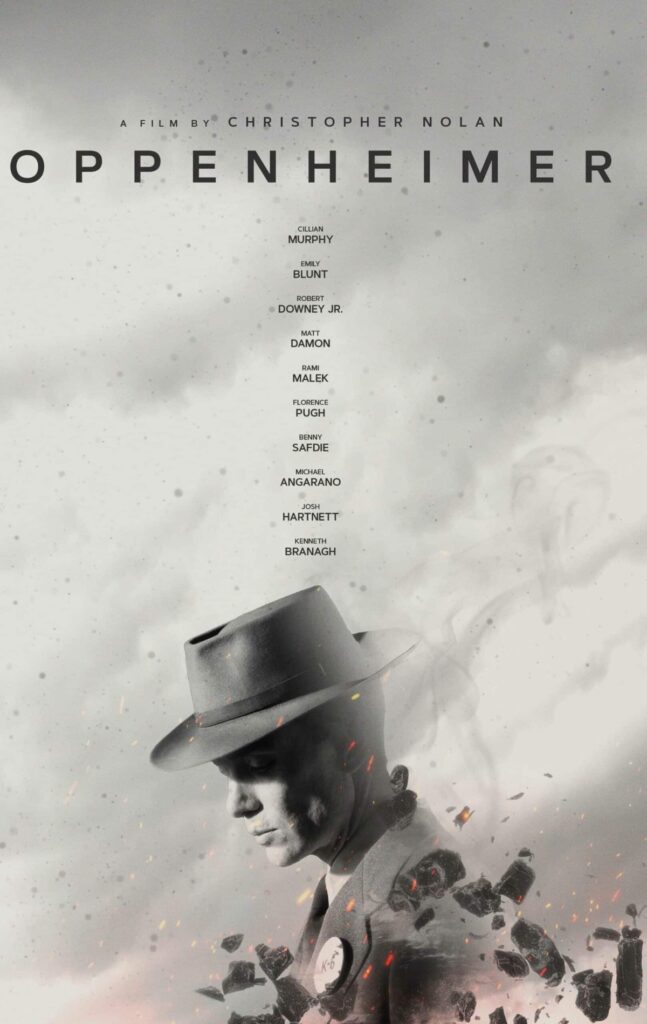
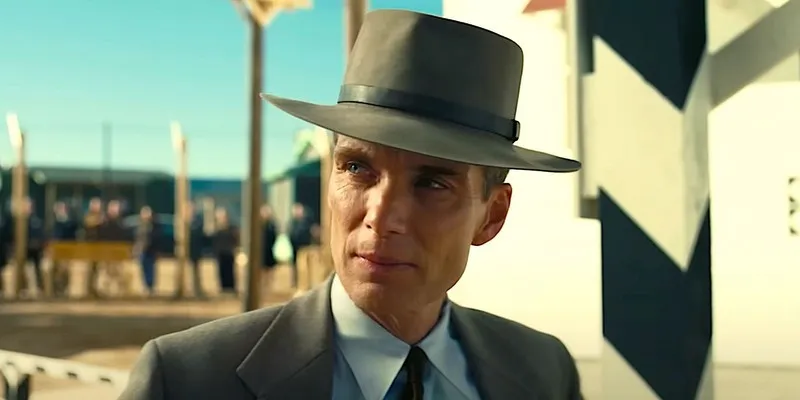
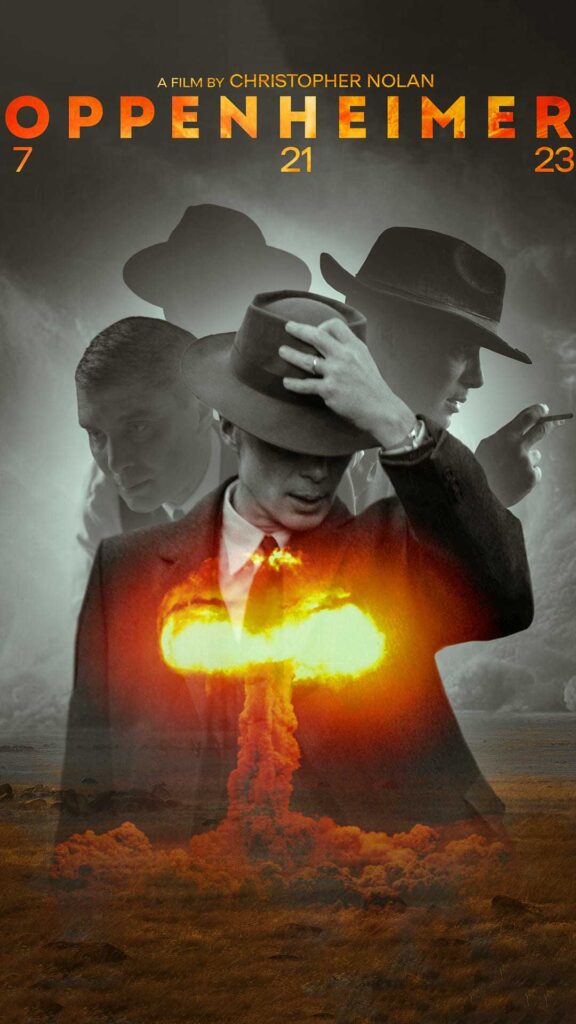
Symbolism
- Atomic Bomb:
- Symbol of Power: Represents the unprecedented power of nuclear technology and its transformative impact on global politics and warfare.
- Ethical Quandaries: Symbolizes the ethical dilemmas faced by scientists involved in developing weapons of mass destruction, prompting viewers to contemplate the moral responsibilities of scientific discovery.
- Cultural Iconography: Reflects the cultural and historical significance of the atomic bomb, symbolizing both scientific achievement and existential threat.
- Desert Landscape:
- Isolation and Secrecy: Symbolizes the isolated and clandestine nature of scientific research during wartime, emphasizing the secrecy and urgency of the Manhattan Project.
- Environmental Impact: Reflects the environmental and geographical context of the Los Alamos laboratory, underscoring the remote and barren setting where scientific history was made.
- Metaphorical Space: Serves as a metaphorical space for introspection and moral contemplation, contrasting the vastness of the desert with the weight of ethical decisions.
Cinematography
- Visual Style:
- Narrative Visual Language: Establishes a visual language that reinforces thematic motifs and character dynamics, using composition, lighting, and color to enhance storytelling.
- Symbolic Imagery: Incorporates symbolic imagery and visual metaphors to convey complex themes and emotional resonance, engaging viewers on a visceral and intellectual level.
- Historical Authenticity: Captures the historical authenticity of the era through meticulous attention to detail in set design, costume, and period-specific visual elements.
- Camera Work:
- Dynamic Cinematography: Utilizes dynamic camera movements to amplify dramatic tension and emotional intensity during key narrative moments.
- Perspective and Point of View: Alternates between different perspectives to provide insight into characters’ motivations, dilemmas, and emotional states.
- Visual Composition: Composes shots that evoke a sense of scale, intimacy, and psychological depth, immersing viewers in the characters’ emotional and moral dilemmas.
- Color Palette:
- Emotional Tonality: Manipulates color palettes to establish emotional tonalities and atmospheric moods that resonate with the narrative’s thematic arcs.
- Symbolic Color Use: Utilizes color symbolism to underscore thematic elements such as power dynamics, moral ambiguity, and existential contemplation.
Visual Contrast: Creates visual contrast between light and shadow, accentuating narrative tensions and character dynamics within the frame.

Soundtrack
- Emotional Resonance: Curates a soundtrack that enhances emotional resonance and thematic depth, using music to underscore pivotal moments and character developments.
- Historical Context: Integrates period-specific music to evoke the historical authenticity and cultural milieu of the World War II era, immersing viewers in the film’s temporal and spatial setting.
- Narrative Integration: Seamlessly integrates music with narrative pacing and visual storytelling, enhancing the audience’s engagement and emotional investment in the story.
Sound Design
- Ambient Soundscape: Constructs an immersive soundscape that reflects the environmental, technological, and emotional landscapes of the narrative world.
- Symbolic Sound Elements: Incorporates symbolic sound elements (e.g., mechanical noises, atmospheric hums) to underscore thematic motifs such as scientific innovation, existential dread, and moral introspection.
- Emotional Texture: Enhances the film’s emotional texture and narrative depth through sound design that mirrors characters’ internal states, external conflicts, and moral dilemmas.
- Musical Style: Ludwig Göransson’s score for “Oppenheimer” blends orchestral compositions with electronic elements, creating a dynamic and atmospheric soundtrack that complements the film’s narrative and emotional arcs.
- Themes and Motifs: The score features recurring motifs that reflect the film’s themes of scientific discovery, moral ambiguity, and the personal turmoil of J. Robert Oppenheimer. Göransson’s use of thematic development enhances character introspection and underscores pivotal moments in the story.
- Historical Context: The composer researched period-appropriate musical styles and instrumentation to evoke the atmosphere of the 1940s. This attention to historical detail enriches the audience’s immersion in the film’s setting and enhances its authenticity.
Sound Designer
- Acoustic Realism: The sound design in “Oppenheimer” focuses on acoustic realism, capturing the ambient sounds of 1940s laboratories, military bases, and outdoor environments. This attention to detail contributes to the film’s immersive quality and historical accuracy.
- Trinity Test Sequence: Special emphasis is placed on the sound effects during the Trinity test sequence, where meticulous sound engineering replicates the awe-inspiring and terrifying aspects of the atomic explosion. The use of low-frequency sounds and reverberation techniques enhances the impact of this pivotal moment in history.
- Dialog Clarity: Clear and nuanced dialog ensures that character interactions and verbal exchanges are crisp and intelligible amidst the film’s complex thematic discussions and narrative layers.

Technical Details and Techniques
- Integration with Visuals: The music and sound effects are seamlessly integrated with the film’s visuals, enhancing emotional resonance and narrative coherence. Strategic use of sound bridges and transitions ensures smooth transitions between scenes and reinforces thematic connections.
- Innovative Approaches: Innovative techniques, such as layering different musical textures and experimenting with unconventional instrument combinations, contribute to the unique auditory experience of “Oppenheimer.” These creative choices reflect the director’s vision and enhance the film’s overall impact.
Emotional and Narrative Impact
- Emotional Resonance: The combination of music and sound effects heightens emotional moments and character development, allowing audiences to connect deeply with the film’s protagonists and their moral dilemmas.
- Narrative Functionality: Beyond aesthetic considerations, the music and sound design serve a narrative function by guiding audience emotions, signaling transitions, and reinforcing thematic motifs throughout the film’s non-linear structure.
The music and sound design in “Oppenheimer” play pivotal roles in enhancing its cinematic experience. Through meticulous composition, historical accuracy, and innovative techniques, Ludwig Göransson’s score and the film’s sound design team contribute significantly to the film’s narrative depth, emotional impact, and overall artistic achievement.
- Auteur Approach:
- Narrative Complexity: Crafts a narrative that challenges viewers’ perceptions and stimulates intellectual engagement through layered storytelling and thematic exploration.
- Philosophical Undercurrents: Infuses philosophical undercurrents into the narrative, prompting audiences to contemplate broader questions about science, ethics, and human agency.
- Visual and Narrative Cohesion: Achieves coherence between visual style, narrative structure, and thematic content, creating a cinematic experience that is both artistically cohesive and intellectually stimulating.
- Visual and Narrative Innovations:
- Innovative Storytelling Techniques: Experimentation with narrative structure, pacing, and character development to offer a fresh perspective on historical events and moral dilemmas.
- Visual Experimentation: Pushes the boundaries of visual storytelling through innovative camera techniques, cinematographic choices, and symbolic imagery that challenge cinematic conventions.
- Cultural and Historical Commentary: Provides insightful commentary on cultural and historical contexts through nuanced characterizations, evocative visuals, and resonant thematic exploration.
- Introduction to Oppenheimer: The film begins by portraying J. Robert Oppenheimer as a young physicist renowned for his intellectual prowess and unorthodox approach to science. His early career highlights his deep engagement with theoretical physics and his emergence as a leading figure in the scientific community. Oppenheimer’s character is introduced with a sense of intellectual curiosity and moral integrity, setting the stage for the ethical dilemmas he will face later. The narrative paints a picture of a man driven by the pursuit of knowledge but increasingly aware of the implications of his scientific discoveries in the context of a world torn apart by war.
- Decision to Join the Manhattan Project: Oppenheimer’s pivotal decision to join the Manhattan Project is depicted through a series of deliberative scenes that underscore the gravity of his choice. Initially reluctant due to ethical concerns about the military applications of atomic energy, Oppenheimer is ultimately swayed by the urgency of the Allied war effort and the belief that developing the atomic bomb could decisively end the war. This decision is a turning point in the narrative, revealing Oppenheimer’s inner conflict between his scientific ideals and the practical realities of wartime necessity. It sets the stage for his transformation from a reluctant participant to a central figure in the development of nuclear weapons.
- Building Los Alamos: The portrayal of Los Alamos as the clandestine research facility where Oppenheimer and his team assemble is pivotal in illustrating the logistical and scientific challenges of the Manhattan Project. The scenes at Los Alamos showcase Oppenheimer’s leadership skills as he manages a diverse team of scientists, engineers, and military personnel under conditions of strict secrecy. The laboratory becomes a crucible of innovation and collaboration, where theoretical concepts are translated into practical applications amidst the pressures of wartime urgency. These scenes highlight the immense technical and organizational complexities involved in harnessing atomic energy for military purposes.
- Test of the Atomic Bomb (Trinity Test): The Trinity Test, where the first atomic bomb is detonated in the New Mexico desert, is a cinematic climax that captures the monumental significance of Oppenheimer’s scientific achievement. The scene unfolds with a mix of awe and dread as Oppenheimer and his team witness the unprecedented power of nuclear fission unleashed. The visual spectacle of the explosion underscores the technological triumph of the Manhattan Project while foreshadowing the devastating implications for humanity. This moment marks a profound shift in Oppenheimer’s understanding of the consequences of his work, as he grapples with the realization of the bomb’s destructive potential.
- Hiroshima and Nagasaki: The aftermath of the bombings of Hiroshima and Nagasaki is depicted with haunting realism, emphasizing the human toll of Oppenheimer’s scientific breakthrough. Through harrowing scenes of destruction and suffering, the film confronts the moral implications of using atomic weapons on civilian populations. Oppenheimer’s anguish and moral anguish are palpable as he witnesses the catastrophic consequences of his creation. These scenes delve into his internal struggle with guilt and responsibility, highlighting the profound ethical dilemmas faced by scientists who become unwitting architects of mass destruction.
- Oppenheimer’s Reflections: Throughout the narrative, moments of introspection provide insight into Oppenheimer’s evolving perspective on the ethical dimensions of scientific discovery. These contemplative scenes offer a glimpse into his intellectual and emotional turmoil as he grapples with the dual nature of scientific progress—its potential for both enlightenment and devastation. Oppenheimer’s introspective journey reveals his growing awareness of the moral complexities inherent in wielding scientific knowledge as a tool of war, challenging viewers to ponder the broader implications of technological innovation in the context of global conflict.
- Legacy and Historical Context: The concluding scenes of the film explore Oppenheimer’s enduring legacy and the broader historical context of the atomic age. They examine how his role in the Manhattan Project shaped the trajectory of global politics, military strategy, and scientific ethics in the post-war era. The film raises profound questions about the accountability of scientists, the ethical responsibilities of technological advancement, and the long-term consequences of nuclear proliferation. Oppenheimer’s legacy serves as a cautionary tale about the unintended consequences of scientific innovation and the enduring impact of decisions made in the crucible of wartime urgency.
By expanding on these key scenes and moments, “Oppenheimer” offers a comprehensive exploration of the complex interplay between science, morality, and global conflict. It challenges viewers to contemplate the ethical dilemmas faced by scientists who navigate the dual responsibilities of discovery and its application in the pursuit of national security.
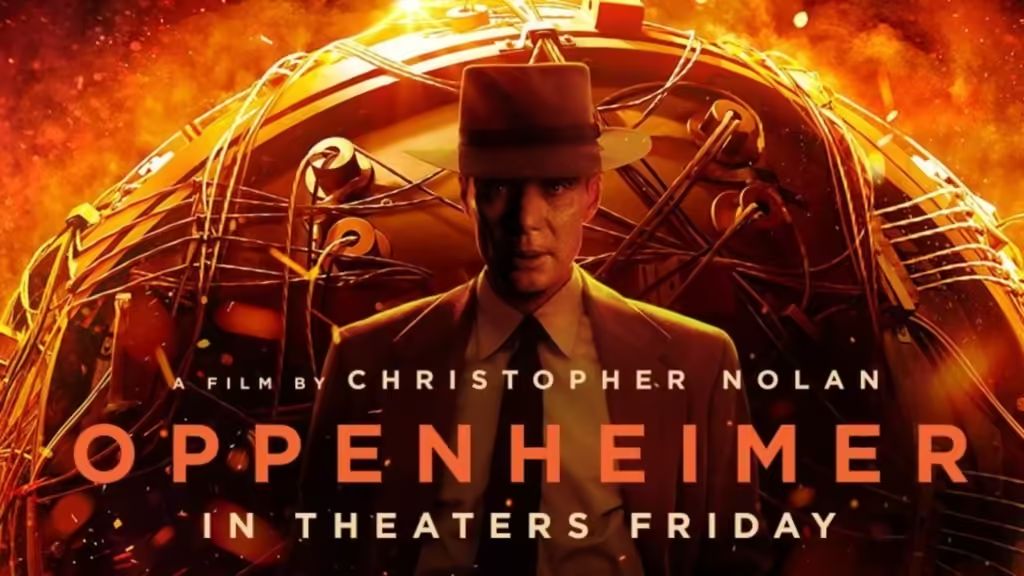
1. The Ethical Dilemma of Scientific Discovery
Interpretation: The film’s central theme revolves around the ethical complexities faced by scientists, particularly in the context of wartime research and development. Oppenheimer’s internal struggle with the moral implications of creating the atomic bomb is depicted with great nuance.
Popular Theories:
- Utilitarian Perspective: Oppenheimer’s decision to lead the Manhattan Project can be seen through a utilitarian lens, where the ultimate goal was to end World War II swiftly, potentially saving millions of lives. This perspective argues that the immediate destruction caused by the bombs on Hiroshima and Nagasaki was a necessary evil to prevent further, possibly greater, suffering.
- Historical Context: Fans and critics often cite historical documents and Oppenheimer’s own statements to support this view. He believed that developing the bomb before the Axis powers did was crucial to ensuring Allied victory.
- Counterarguments: Critics of this view argue that the bombings were not solely justified on military grounds but were also influenced by geopolitical considerations, such as demonstrating power to the Soviet Union.
- Moral Ambiguity: The film portrays Oppenheimer as a tragic figure, suggesting that the moral consequences of his work weighed heavily on him. His famous quote, “Now I am become Death, the destroyer of worlds,” encapsulates this internal conflict.
- Character Depth: This interpretation highlights the complexity of Oppenheimer’s character, depicting him as someone who understood the profound and far-reaching implications of his creation.
- Broader Message: The moral ambiguity serves as a commentary on the dual-edged nature of scientific advancements and the ethical responsibilities of those who wield such power.
My Insight: The film masterfully portrays the dual-edged nature of scientific progress. Oppenheimer’s character reflects the internal conflict that many scientists face when their discoveries have both beneficial and destructive potential. This ambiguity is a poignant reminder of the ethical responsibilities that come with great power.
2. Oppenheimer’s Relationships and Personal Struggles
Interpretation: The film delves into Oppenheimer’s personal life, portraying how his relationships and personal struggles are deeply intertwined with his professional life.
Popular Theories:
- Emotional Isolation: Some critics interpret Oppenheimer’s strained relationships as a representation of his emotional isolation. The immense pressure and secrecy surrounding the Manhattan Project created a barrier between him and his loved ones.
- Scenes of Isolation: Key scenes show Oppenheimer working late into the night, distanced from family and friends, emphasizing his solitary journey.
- Impact on Personal Life: His marriage to Kitty Oppenheimer and relationships with colleagues are shown to be strained, reflecting the personal cost of his professional dedication.
- Intellectual Arrogance: Others view his interactions as indicative of intellectual arrogance. His genius and the sense of purpose derived from the project made it difficult for him to connect with those who could not understand the magnitude of his work.
- Character Interactions: Scenes where Oppenheimer dismisses concerns from his peers or clashes with military officials highlight this aspect of his personality.
- Alienation: This arrogance, coupled with the high stakes of his work, contributes to his sense of alienation from those around him.
My Insight: Oppenheimer’s personal struggles highlight the often overlooked human aspect of scientific endeavor. The film suggests that the pressures of groundbreaking work can lead to personal sacrifices and emotional turmoil, painting a holistic picture of Oppenheimer as both a genius and a flawed human being.
3. The Symbolism of the Trinity Test
Interpretation: The Trinity test is a pivotal moment in the film, rich with symbolism and dramatic tension. It represents not just a scientific achievement, but a profound turning point in human history.
Popular Theories:
- Birth of a New Era: The test is seen as the symbolic birth of a new era, where humanity wields the power to destroy itself. The dramatic portrayal of the explosion serves as a metaphor for this newfound destructive capability.
- Cinematic Techniques: The use of slow-motion, intense sound design, and visual effects during the explosion emphasizes its earth-shattering significance.
- Historical Significance: The film uses this moment to underline the irreversible change in global power dynamics and the onset of the nuclear age.
- Religious Imagery: Others see religious symbolism in the test’s name and execution, suggesting parallels to the Christian Holy Trinity and the idea of playing God by creating such immense destructive power.
- Philosophical Reflections: Oppenheimer’s reflections and the invocation of the Bhagavad Gita (“Now I am become Death, the destroyer of worlds”) add a layer of spiritual and existential meaning.
- Ethical Implications: This religious imagery underscores the ethical and moral gravity of creating a weapon of mass destruction.
My Insight: The Trinity test scene encapsulates the awe and terror of scientific discovery. It’s a moment that marks a drastic shift in the human condition, where the boundaries of what is possible are forever altered. The religious symbolism underscores the moral gravity of this power, inviting viewers to reflect on the ethical implications of wielding such force.
4. The Post-War Fallout and Oppenheimer’s Legacy
Interpretation: The film’s depiction of Oppenheimer’s post-war experiences and his fallout with the government highlights the political and personal consequences of his work.
Popular Theories:
- Political Sacrifice: Some critics argue that Oppenheimer was made a political scapegoat, punished for his later opposition to nuclear proliferation and for his perceived communist sympathies during the Red Scare.
- McCarthyism: The film portrays the intense scrutiny and suspicion Oppenheimer faced during the Red Scare, capturing the political climate of the time.
- Security Hearings: His security clearance hearings are depicted as a witch hunt, reflecting the paranoia and political maneuvering of the era.
- Philosophical Reflection: Others suggest that the latter part of the film is a philosophical reflection on the nature of legacy and the burdens of conscience, portraying Oppenheimer as a tragic figure wrestling with the outcomes of his achievements.
- Moral Reckoning: Oppenheimer’s reflections on his role in creating the bomb and its use highlight his ongoing moral and ethical struggle.
- Enduring Impact: The film suggests that his legacy is complex, encompassing both his scientific achievements and the devastating consequences of those achievements.
My Insight: The post-war narrative of Oppenheimer’s life underscores the complex interplay between politics, science, and personal integrity. The film suggests that even those who achieve great things are not immune to the machinations of politics and society. Oppenheimer’s story serves as a cautionary tale about the costs of ambition and the relentless pursuit of progress.
5. The Duality of Genius
Interpretation: Throughout the film, Oppenheimer is portrayed as a character embodying the duality of genius—both a creator and a destroyer.
Popular Theories:
- Hero and Villain: Some viewers see Oppenheimer as a hero for his scientific achievements and a villain for his role in creating the atomic bomb, reflecting the duality of human nature.
- Complex Legacy: The film presents a balanced view, neither fully glorifying nor condemning him, allowing viewers to form their own judgments about his legacy.
- Character Complexity: This duality is reflected in Oppenheimer’s interactions, where he is both admired for his intellect and criticized for the moral implications of his work.
- Burden of Knowledge: Others interpret the film as a meditation on the burden of knowledge, suggesting that Oppenheimer’s genius came with a heavy price, both personally and for humanity.
- Psychological Toll: The film depicts the psychological toll of his work, showing how the burden of creating a weapon of mass destruction weighed heavily on him.
- Philosophical Questions: This interpretation raises philosophical questions about the responsibilities and ethical dilemmas faced by those who push the boundaries of human knowledge.
My Insight: The film’s portrayal of Oppenheimer highlights the inherent contradictions of genius. His story is a powerful reminder that the pursuit of knowledge and progress can lead to unintended and often tragic consequences. This duality is at the heart of the film’s exploration of the human condition, inviting viewers to grapple with the complex legacy of scientific innovation.
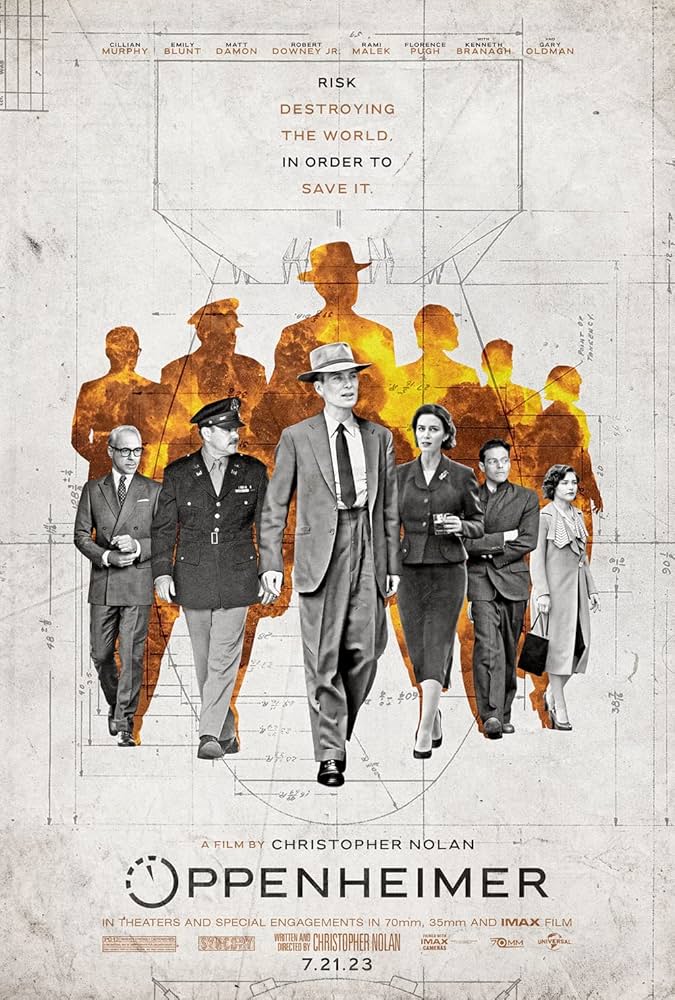
“Oppenheimer,” directed by Christopher Nolan, received widespread acclaim from critics and audiences alike for its ambitious storytelling and exploration of ethical dilemmas. Here’s a brief summary of its reception:
- Critical Acclaim: Critics praised Nolan’s direction, Hoyte van Hoytema’s cinematography, and Ludwig Göransson’s score. The film’s non-linear narrative and psychological depth were highlighted as strengths, offering a nuanced portrayal of J. Robert Oppenheimer’s moral struggles and the consequences of scientific discovery.
- Audience Response: Audiences resonated with the film’s thought-provoking themes and intense emotional impact. Many appreciated its historical accuracy and the way it humanized Oppenheimer while grappling with complex ethical questions.
- Awards and Nominations: “Oppenheimer” garnered several nominations across major award ceremonies, including Best Director for Christopher Nolan, Best Actor for the lead role, and technical categories such as cinematography and sound design. While specific wins may vary, the film’s presence in award nominations underscored its artistic and technical achievements.
Overall, “Oppenheimer” continues to be celebrated for its innovative storytelling and profound exploration of historical and ethical themes, cementing its place as a critically acclaimed film in the cinematic landscape.
1. Historical Accuracy and Realism
- Authentic Locations: Much of the film was shot in actual locations related to the Manhattan Project. The scenes set in Los Alamos were filmed in New Mexico, adding an authentic historical feel to the movie.
- Consultation with Historians: To ensure historical accuracy, the filmmakers consulted with several historians and experts on the Manhattan Project. This helped in portraying the events and characters as realistically as possible.
- Period-Accurate Props: The props used in the film, from scientific instruments to everyday objects, were meticulously researched and recreated to match the 1940s period accurately.
2. Casting Choices
- Cillian Murphy as Oppenheimer: Cillian Murphy was cast as J. Robert Oppenheimer after an extensive selection process. Director Christopher Nolan has praised Murphy’s ability to convey the complexity and depth of Oppenheimer’s character.
- Star-Studded Cast: The film features a star-studded cast, including Matt Damon as General Leslie Groves, Emily Blunt as Kitty Oppenheimer, and Robert Downey Jr. as Lewis Strauss. Each actor underwent rigorous preparation to accurately portray their historical counterparts.
- Character Transformation: Many cast members underwent significant physical transformations for their roles. For instance, Cillian Murphy lost weight to portray the lean figure of Oppenheimer, and Emily Blunt studied Kitty Oppenheimer’s mannerisms and speech to embody her character authentically.
3. Production Challenges
- Recreating the Trinity Test: One of the most challenging scenes to film was the Trinity test. The filmmakers used a combination of practical effects and CGI to recreate the first atomic explosion convincingly. This scene is noted for its intense visual and auditory impact.
- Attention to Detail: The production team paid meticulous attention to the details of the 1940s era, from costumes and props to the design of the laboratories and equipment used in the Manhattan Project.
- Weather Challenges: Filming in New Mexico presented weather challenges, including extreme heat and unpredictable conditions, which the crew had to navigate to keep the production on schedule.
4. Nolan’s Direction and Vision
- Director’s Commitment: Christopher Nolan is known for his commitment to practical effects and immersive storytelling. For “Oppenheimer,” he focused on creating an authentic atmosphere that would transport audiences back to the 1940s.
- Narrative Style: Nolan’s non-linear narrative style is evident in “Oppenheimer.” The film interweaves different time periods and perspectives, offering a multifaceted view of Oppenheimer’s life and the development of the atomic bomb.
- Visual Storytelling: Nolan used a combination of wide shots and close-ups to capture the grandeur of the scientific achievements and the intimate personal struggles of the characters.
5. Music and Sound Design
- Original Score: The film’s score, composed by Hans Zimmer, plays a crucial role in building tension and conveying the emotional weight of the story. Zimmer’s use of orchestral and electronic elements adds a unique texture to the film’s soundscape.
- Sound Effects: The sound design for the Trinity test and other critical scenes involved extensive research and innovation. The goal was to create a sound experience that would be both realistic and emotionally impactful.
- Silence as a Tool: Nolan strategically used moments of silence in the film, particularly during the explosion, to create a stark contrast and enhance the impact of the scenes.
6. Historical Figures and Cameos
- Depiction of Historical Figures: The film features portrayals of several key historical figures involved in the Manhattan Project, including Enrico Fermi, Richard Feynman, and Niels Bohr. The actors studied these figures extensively to deliver accurate and compelling performances.
- Cameos: There are a few cameos from well-known actors playing minor but significant roles, adding depth and authenticity to the portrayal of the scientific community of the time.
- Historical Accuracy in Casting: Efforts were made to cast actors who not only resembled the historical figures but could also capture their personalities and mannerisms accurately.
7. Critical Acclaim and Reception
- Critical Reception: “Oppenheimer” has received widespread critical acclaim for its direction, screenplay, and performances. Critics have particularly praised Cillian Murphy’s portrayal of the titular character and the film’s handling of complex moral and ethical questions.
- Box Office Success: The film has also performed well at the box office, drawing audiences with its gripping story and historical significance.
- Award Nominations: “Oppenheimer” has garnered numerous nominations and awards, particularly in categories such as Best Actor, Best Director, and Best Cinematography.
8. Real-Life Inspirations
- Historical Quotes: The script incorporates several historical quotes and speeches from Oppenheimer and other key figures, lending authenticity and depth to the dialogue.
- Scientific Consultation: The filmmakers consulted with scientists to accurately depict the physics involved in the Manhattan Project and to ensure that the scientific explanations were clear and accurate for the audience.
- Personal Letters and Diaries: Personal letters and diaries of Oppenheimer and his colleagues were used as source material to provide a more intimate and detailed portrayal of their experiences.
9. Technological Innovation
- Cutting-Edge Technology: In addition to practical effects, the film utilized cutting-edge technology for visual effects, particularly in depicting the atomic explosion and its aftermath.
- IMAX Filming: Parts of the film were shot using IMAX cameras to enhance the visual experience, particularly for the large-scale, impactful scenes like the Trinity test.
- Special Effects Techniques: The special effects team developed new techniques to realistically portray the intense light and energy of the atomic blast.
10. Themes and Symbolism
- Philosophical Themes: The film explores deep philosophical themes, such as the ethical implications of scientific discovery and the duality of human nature. These themes are woven into the narrative through dialogue and visual storytelling.
- Symbolic Imagery: Symbolic imagery is used throughout the film to underscore its themes. For example, the recurring motif of the bomb’s explosion serves as a metaphor for the unleashing of human potential and its catastrophic consequences.
- Visual Metaphors: Visual metaphors, such as the use of light and shadow, are employed to highlight the contrasts in Oppenheimer’s character and the dual nature of his achievements.
11. Audience Engagement
- Interactive Marketing: The marketing campaign for “Oppenheimer” included interactive elements, such as online puzzles and historical teasers, to engage the audience and build anticipation for the film.
- Historical Exhibitions: Prior to the film’s release, exhibitions showcasing the history of the Manhattan Project and the making of the movie were held in several cities, attracting history buffs and film enthusiasts alike.
- Educational Outreach: Educational materials and discussions were promoted in conjunction with the film to encourage audiences to learn more about the historical context and scientific principles depicted in the story.
12. Legacy and Impact
- Cultural Impact: “Oppenheimer” has sparked renewed interest in the history of the Manhattan Project and the ethical considerations of nuclear weapons, leading to public debates and discussions.
- Influence on Science Films: The film’s success has set a new standard for science and history films, demonstrating the potential for compelling storytelling that is both educational and entertaining.
- Ongoing Relevance: The themes explored in “Oppenheimer” remain relevant today, reflecting ongoing concerns about scientific responsibility and the impact of technological advancements on society.
1. “Now I am become Death, the destroyer of worlds.”
Context: This quote is taken from the Bhagavad Gita, a 700-verse Hindu scripture that discusses the moral and philosophical dilemmas faced by a warrior prince. In the film, Oppenheimer reflects on this line after the successful Trinity test, the first detonation of an atomic bomb on July 16, 1945. The moment is portrayed as one of intense introspection for Oppenheimer, as he contemplates the destructive power he has helped to create. The quote signifies his realization of the bomb’s devastating potential and his personal struggle with the moral implications of his scientific achievement. This line is often used to underscore the profound psychological impact and sense of responsibility that Oppenheimer felt.
2. “We knew the world would not be the same.”
Context: Oppenheimer says this line in a somber tone, reflecting on the irreversible impact of the atomic bomb on global politics and human history. This moment in the film captures Oppenheimer’s acknowledgment of the significant and lasting changes brought about by their scientific work. It highlights the dawn of the nuclear age and the resulting shift in geopolitical power dynamics. This quote serves to illustrate the weight of their actions and the awareness among the scientists that their creation would fundamentally alter the course of history.
3. “I feel like I have blood on my hands.”
Context: This line is delivered by Oppenheimer in a deeply emotional moment after the bombings of Hiroshima and Nagasaki. The film portrays him grappling with immense guilt and remorse, struggling to reconcile his role in the creation of the bomb with the massive loss of life and suffering it caused. This quote encapsulates his sense of personal responsibility and the moral burden he carries, illustrating the internal conflict and emotional turmoil faced by many of the scientists involved in the Manhattan Project.
4. “The physicists have known sin; and this is a knowledge which they cannot lose.”
Context: Oppenheimer makes this statement during a conversation with his colleagues, reflecting on the ethical implications of their work. The quote underscores the moral burden that the scientists bear for their role in creating weapons of mass destruction. It highlights the irreversible nature of their knowledge and the lasting impact of their discoveries. This line serves as a powerful commentary on the ethical dilemmas faced by the scientific community and the profound consequences of their actions.
5. “It’s not about who has the most destructive weapon. It’s about who uses it and how.”
Context: This quote is delivered during a heated debate about nuclear proliferation and the future use of atomic weapons. It emphasizes the importance of responsible stewardship and the ethical considerations surrounding the use of such powerful technology. The film uses this line to highlight the ongoing debate about nuclear weapons and the responsibility of those who possess them to use them wisely and judiciously. It serves as a reminder of the ethical complexities involved in wielding such destructive power.
6. “We did it for the right reasons, but that doesn’t mean it was right.”
Context: This quote reflects the complex moral landscape the characters navigate throughout the film. It is spoken in a moment of introspection, as the characters grapple with the ethical implications of their actions. The line underscores the notion that good intentions do not necessarily justify actions with far-reaching and potentially catastrophic consequences. It serves as a poignant reminder of the moral ambiguity and ethical challenges faced by those involved in the Manhattan Project.
7. “What we did here changed the world forever.”
Context: Oppenheimer says this while addressing his team after the successful Trinity test. This line captures the sense of achievement and the weight of their accomplishment, recognizing that their work has irrevocably altered the course of history. It highlights the pride and responsibility felt by the scientists, acknowledging the profound impact of their creation on the world. This quote serves to underscore the historical significance of the moment and the lasting legacy of their work.
8. “In this business, there are no heroes, only survivors.”
Context: This line is spoken by a colleague of Oppenheimer’s, reflecting the harsh realities of wartime research and the personal sacrifices made by those involved. It highlights the disillusionment and pragmatic outlook that many of the characters develop over the course of the film. The quote serves to underscore the personal costs and moral complexities faced by the scientists, emphasizing the challenges and hardships of their work.
9. “The bomb is just the beginning. What comes next is what matters.”
Context: This line is delivered in a discussion about the future implications of nuclear technology. It underscores the idea that the creation of the atomic bomb is only the first step in a broader narrative about power, politics, and human responsibility. The film uses this quote to highlight the ongoing challenges and ethical considerations that arise from the development of nuclear weapons, emphasizing the importance of responsible decision-making and foresight.
10. “I have unlocked a door that cannot be closed.”
Context: Oppenheimer says this towards the end of the film, reflecting on the irreversible nature of his scientific breakthrough. It symbolizes the Pandora’s box effect of nuclear technology and the permanent change it has brought to the world. This quote serves to illustrate the profound and lasting impact of their work, emphasizing the ethical and moral dilemmas faced by the scientists and the far-reaching consequences of their actions.
1. “The Imitation Game” (2014)
Comparison:
- Historical Context: Both films are set during World War II and focus on brilliant scientists whose work has a profound impact on the outcome of the war. “The Imitation Game” follows Alan Turing as he works to crack the Enigma code, while “Oppenheimer” chronicles the development of the atomic bomb.
- Ethical Dilemmas: Both films explore the ethical implications of scientific advancements. Turing’s work on breaking the Enigma code raises questions about the cost of secrecy and the value of individual lives, while Oppenheimer grapples with the morality of creating a weapon of mass destruction.
- Character Studies: Both films offer deep character studies of their protagonists. Turing and Oppenheimer are portrayed as complex, flawed individuals whose genius comes with personal and moral challenges.
2. “Fat Man and Little Boy” (1989)
Comparison:
- Subject Matter: “Fat Man and Little Boy” directly covers the same historical event as “Oppenheimer,” focusing on the Manhattan Project and the creation of the first atomic bombs. Both films depict the intense scientific efforts and the ethical considerations involved.
- Character Focus: While “Oppenheimer” centers primarily on J. Robert Oppenheimer, “Fat Man and Little Boy” gives equal attention to General Leslie Groves, the military leader of the Manhattan Project, played by Paul Newman. This dual focus provides a broader perspective on the project’s execution.
- Tone and Style: “Fat Man and Little Boy” has a more traditional biopic style, whereas “Oppenheimer,” directed by Christopher Nolan, employs a non-linear narrative and psychological depth to explore Oppenheimer’s internal struggles and moral conflicts.
3. “Doctor Strangelove or: How I Learned to Stop Worrying and Love the Bomb” (1964)
Comparison:
- Themes of Nuclear Warfare: Both films deal with the subject of nuclear weapons, but from very different angles. “Doctor Strangelove” is a satirical black comedy that critiques the absurdity and dangers of nuclear brinkmanship, while “Oppenheimer” is a serious historical drama focusing on the creation of the bomb and its ethical implications.
- Tone and Genre: “Doctor Strangelove” uses humor and satire to make its points, contrasting sharply with the serious, introspective tone of “Oppenheimer.” Despite this, both films leave viewers with a deep sense of the existential risks associated with nuclear weapons.
- Historical Context: “Doctor Strangelove” reflects Cold War anxieties and the threat of mutually assured destruction, while “Oppenheimer” delves into the origins of these fears by depicting the invention of nuclear weapons.
4. “Hiroshima” (1995)
Comparison:
- Focus on Impact: “Hiroshima” is a historical drama that focuses on the impact of the atomic bombings on Japan and the decision-making process leading up to it. It offers a perspective on the consequences of the scientific work depicted in “Oppenheimer.”
- Perspective: While “Oppenheimer” provides insight into the scientists and their moral struggles, “Hiroshima” shifts focus to the political and human impact of the bombings, providing a complementary view on the ramifications of Oppenheimer’s work.
- Emotional Weight: Both films are emotionally intense, but “Hiroshima” emphasizes the immediate human suffering and devastation caused by the bombings, whereas “Oppenheimer” deals more with the ethical and psychological aspects of creating the bomb.
5. “A Beautiful Mind” (2001)
Comparison:
- Character-Driven Narratives: Both films are character-driven narratives focusing on brilliant but troubled scientists. “A Beautiful Mind” follows mathematician John Nash’s struggles with schizophrenia and his groundbreaking work, while “Oppenheimer” centers on J. Robert Oppenheimer’s contributions to nuclear physics and his moral dilemmas.
- Mental and Emotional Struggles: Both films explore the mental and emotional struggles of their protagonists. Nash’s battle with his mental health parallels Oppenheimer’s internal conflict about the consequences of his scientific achievements.
- Recognition and Legacy: Both films highlight the recognition and legacy of their protagonists’ work, showing how their contributions have had a lasting impact on their respective fields and the world.
Comparisons to Source Material:
“American Prometheus: The Triumph and Tragedy of J. Robert Oppenheimer” by Kai Bird and Martin J. Sherwin
Comparison:
- Depth of Detail: The book provides an extensive and detailed account of Oppenheimer’s life, offering insights into his personal, professional, and philosophical struggles. While the film captures many key elements, the book delves deeper into the intricacies of Oppenheimer’s relationships, thoughts, and the political context of his time.
- Narrative Style: “American Prometheus” is a comprehensive biography that follows a linear progression, whereas Nolan’s film employs a non-linear narrative to explore different facets of Oppenheimer’s life and psyche.
- Character Development: The book offers a more in-depth exploration of secondary characters and their interactions with Oppenheimer, providing a fuller picture of the scientific community and political landscape of the time.
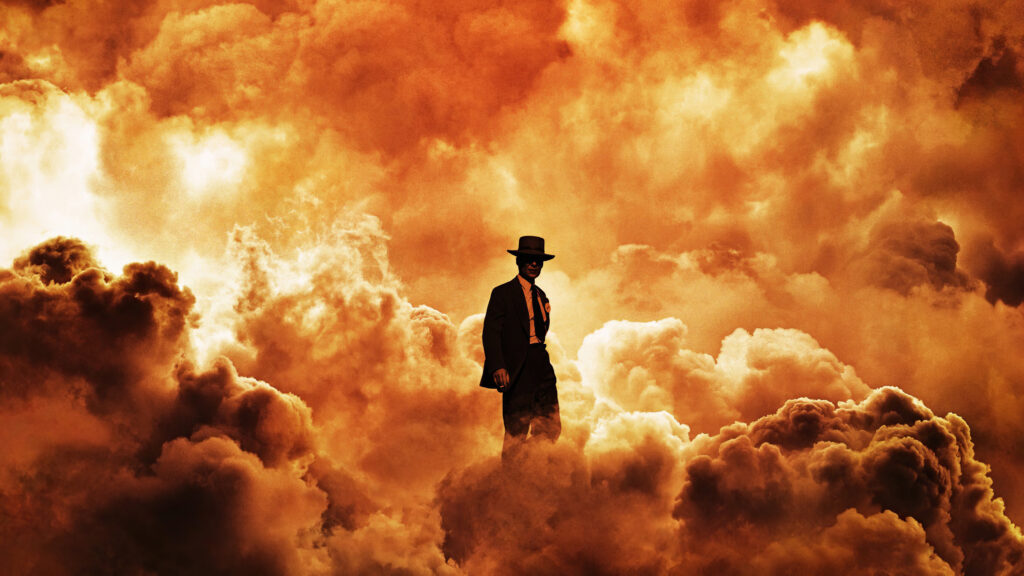
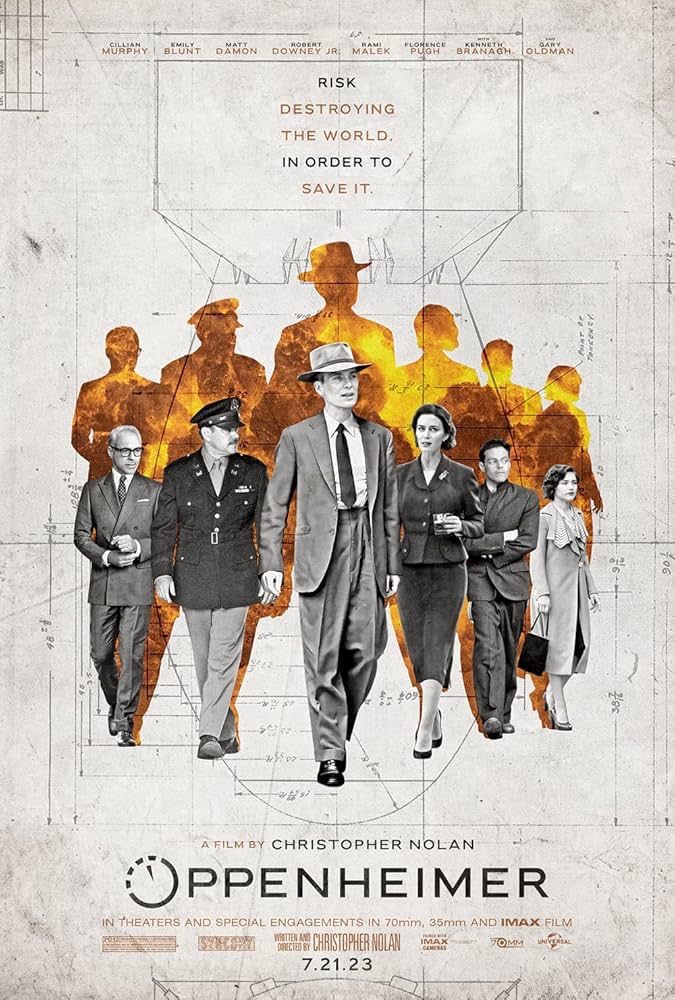
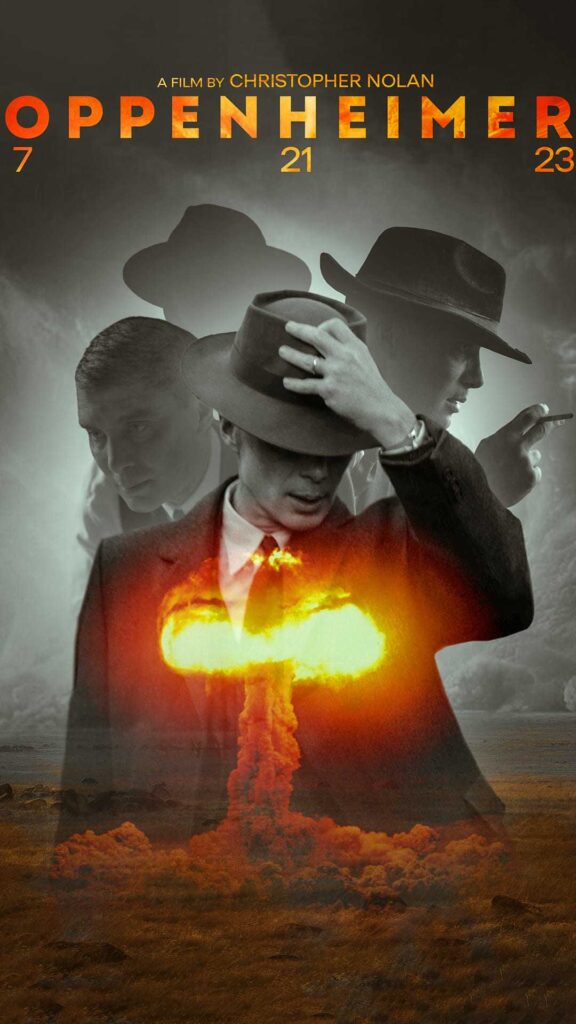

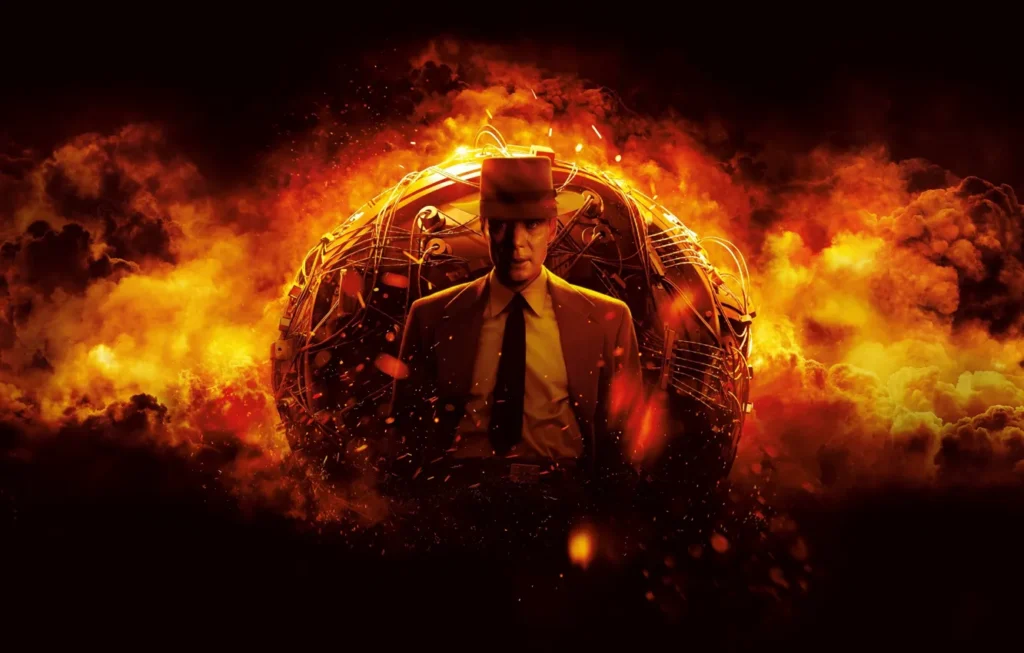
Impact on the Film Industry
1. Innovation in Storytelling:
- Non-linear Narrative: Christopher Nolan’s use of a non-linear narrative in “Oppenheimer” has been praised for its ability to convey complex themes and the multifaceted nature of J. Robert Oppenheimer’s character. This approach challenges traditional biopic storytelling, encouraging filmmakers to explore more innovative narrative structures.
- Character-Driven Drama: By focusing intensely on the internal conflicts and moral dilemmas of Oppenheimer, the film sets a new standard for character-driven historical dramas. This emphasis on deep psychological and ethical exploration may inspire future biopics to delve deeper into the personal lives and motivations of their subjects.
Technical Excellence in “Oppenheimer”
2. Technical Excellence:
1. Practical Effects and Realism:
- Trinity Test Recreation: Christopher Nolan’s commitment to authenticity is evident in the recreation of the Trinity test, the first detonation of an atomic bomb. Instead of relying solely on CGI, Nolan opted for practical effects and meticulous set design to capture the scale and impact of the explosion. This approach involved precise choreography of actors and practical effects teams to simulate the blast’s visual and auditory effects realistically.
- Explosion Dynamics: Special effects teams studied historical footage and accounts to recreate the explosion’s dynamics accurately. This included modeling the shockwave, heat distortion, and mushroom cloud formation, ensuring that the on-screen depiction matched historical records and scientific understanding of nuclear detonations.
2. Cinematography and Visual Style:
- Photographic Realism: The film’s cinematography, under the direction of Hoyte van Hoytema, emphasizes photographic realism. Each frame is carefully composed to capture the period’s aesthetic and atmosphere, from the stark New Mexico desert landscapes to the intense laboratory environments. The use of natural lighting and meticulous attention to detail in set design enhance the film’s authenticity and immersive quality.
- Visual Composition: Nolan’s signature visual style, characterized by wide-angle shots and deep focus, enhances the storytelling by emphasizing both the grandeur and intimacy of the characters’ experiences. The cinematography effectively juxtaposes the monumental scientific achievements with the personal and ethical dilemmas faced by the characters.
3. Sound Design and Atmosphere:
- Acoustic Accuracy: The film’s sound design plays a crucial role in immersing the audience in the world of the Manhattan Project. Sound engineers meticulously recreated the ambient sounds of 1940s laboratories, military facilities, and outdoor environments to enhance the period authenticity. This attention to detail extends to the accurate portrayal of the soundscape during the Trinity test, capturing the awe-inspiring yet terrifying nature of the atomic explosion.
- Emotional Impact: Beyond historical accuracy, the sound design contributes to the film’s emotional resonance. The use of silence and ambient noise during key moments heightens tension and underscores the characters’ internal conflicts. The soundscapes are crafted to evoke a range of emotions, from the quiet contemplation of ethical dilemmas to the visceral impact of wartime urgency.
4. Costume and Set Design:
- Period Authenticity: The costume and set design teams collaborated closely to recreate the 1940s era with meticulous attention to detail. From Oppenheimer’s tailored suits to the military uniforms and scientific equipment, every aspect of the film’s visual presentation reflects extensive historical research and craftsmanship.
- Set Realism: Sets were constructed or adapted to resemble historical locations such as Los Alamos Laboratory and the Trinity test site. Authentic props, furniture, and scientific instruments were sourced or replicated to ensure accuracy, immersing the audience in the daily lives and work environments of the characters.
5. Special Effects and Practical Stunts:
- Realistic Explosions: In addition to the Trinity test, other practical stunts and special effects were used to depict various scientific experiments and wartime scenarios. The film’s practical effects team employed innovative techniques to simulate explosions, gunfire, and other visual effects, enhancing the film’s realism and intensity.
- Stunt Coordination: Professional stunt coordinators worked closely with actors and production crews to ensure the safety and authenticity of action sequences. This included choreographing complex movements and ensuring that actors portrayed wartime activities realistically, from military drills to laboratory experiments.
6. Editing and Post-Production:
- Narrative Structure: Editor Jennifer Lame collaborated with Nolan to maintain the film’s non-linear narrative structure while ensuring coherence and emotional impact. Seamless transitions between past and present events contribute to the film’s storytelling depth, allowing audiences to understand Oppenheimer’s personal and professional evolution over time.
- Visual Effects Integration: While emphasizing practical effects, “Oppenheimer” also incorporates subtle visual effects to enhance storytelling and historical accuracy. Digital enhancements were used sparingly to refine practical sets and environments, ensuring a seamless blend of practical and digital elements.
7. Music Composition and Score:
- Musical Atmosphere: Composer Ludwig Göransson’s score complements the film’s visual and emotional dynamics, ranging from subtle orchestral compositions to evocative electronic soundscapes. The score enhances the film’s tension, drama, and introspective moments, underscoring Oppenheimer’s internal conflicts and the broader implications of his work.
- Historical Sensitivity: Göransson’s research into period-appropriate musical styles and instrumentation ensures that the score resonates authentically with the film’s historical setting. Themes of scientific discovery, moral ambiguity, and existential reflection are conveyed through the score’s thematic motifs and harmonic complexity.
Conclusion:
“Oppenheimer” showcases technical excellence across various filmmaking disciplines, from practical effects and cinematography to sound design and musical composition. Christopher Nolan’s meticulous attention to detail and commitment to authenticity elevate the film, setting new standards for historical dramas and inspiring future filmmakers to explore innovative storytelling techniques. Through its technical achievements, “Oppenheimer” not only immerses audiences in a pivotal moment in history but also enriches cinematic discourse on ethics, responsibility, and the human impact of scientific discovery.
3. Boost for Historical Biopics:
- Renewed Interest: “Oppenheimer” has revitalized interest in historical biopics, demonstrating their potential for critical and commercial success. The film’s success may lead to more investments in high-quality biographical films, especially those dealing with significant historical events and figures.
Cultural Impact
1. Public Awareness and Debate:
- Historical Awareness: The film has brought the story of J. Robert Oppenheimer and the Manhattan Project to a wider audience, educating the public about this crucial period in history. This has sparked renewed interest in the ethical and moral questions surrounding the use of nuclear weapons.
- Ethical Debates: By highlighting Oppenheimer’s moral struggles, the film has encouraged public debate about the responsibilities of scientists and the ethical implications of technological advancements. Discussions about the balance between scientific progress and ethical considerations have been reignited, relevant to contemporary issues such as artificial intelligence and genetic engineering.
2. Influence on Pop Culture:
- Iconic Moments: Scenes from “Oppenheimer,” such as the Trinity test explosion, have become iconic, influencing other media representations of scientific and historical events. The film’s quotes and visual style are likely to be referenced in other works, contributing to its lasting presence in pop culture.
- Memes and References: The profound and thought-provoking dialogue has generated widespread discussion online, with many quotes becoming popular in social media and meme culture. This has extended the film’s reach beyond traditional moviegoers to a broader, younger audience.
3. Educational Value:
- Academic Interest: “Oppenheimer” has piqued the interest of educators and historians, who see the film as a valuable tool for teaching about World War II, the development of nuclear weapons, and the ethical dimensions of scientific research. Screenings and discussions of the film in academic settings are likely to become more common.
- Supplementary Material: The film’s release has led to increased sales and interest in related books, documentaries, and articles. Educational institutions and libraries may incorporate the film into their curricula and resources, furthering its impact on historical education.
Legacy Over Time
1. Enduring Relevance:
- Timeless Themes: The themes of moral responsibility, the ethical implications of scientific discovery, and the personal cost of great achievements ensure that “Oppenheimer” will remain relevant. Future generations are likely to revisit the film for its exploration of these timeless issues.
- Ongoing Discussions: The film’s exploration of the consequences of scientific advancements will continue to be relevant as society grapples with new technological and ethical challenges. “Oppenheimer” will likely be cited in discussions about the role of scientists and the impact of their work on society.
2. Influence on Future Films:
- Inspirational Benchmark: As a benchmark for historical biopics, “Oppenheimer” will influence how future films approach similar subjects. Its success demonstrates the potential for historical films to be both critically acclaimed and commercially successful, encouraging more filmmakers to tackle complex historical narratives.
- Innovation in Filmmaking: Nolan’s innovative techniques and narrative style will inspire future directors to experiment with non-linear storytelling and practical effects, pushing the boundaries of traditional filmmaking.
3. Preservation and Recognition:
- Awards and Honors: Given its critical acclaim, “Oppenheimer” is likely to receive numerous awards and honors, further cementing its place in film history. Recognition from prestigious award bodies will contribute to its legacy and ensure its preservation in cinematic history.
- Archival Preservation: As a significant work in Nolan’s filmography and a landmark historical drama, “Oppenheimer” will be preserved in film archives and may be studied by film students and historians for years to come.
4. Impact on Scientific Discourse:
- Ethical Reflection: The film’s portrayal of the ethical dilemmas faced by Oppenheimer and his colleagues will contribute to ongoing discussions about the role of scientists in society. It may influence how future generations of scientists view their responsibilities and the potential consequences of their work.
- Historical Reflection: By highlighting the human side of scientific endeavors, “Oppenheimer” encourages reflection on the impact of historical events and the people behind them. This humanization of historical figures can foster a deeper understanding of history and its complexities.
Explore Christopher Nolan’s exploration of the moral complexities of scientific discovery in “Oppenheimer.” We invite you to share your thoughts, insights, and reflections on the film’s themes of ethics, responsibility, and the consequences of technological advancement in the comments below. Engage with our community, share your views, and encourage others to join the discussion.
Albert Einstein American physicist Atomic Age Atomic Bomb Atomic Energy Atomic Genesis Cold War famous scientists father of the atomic bomb global impact of Oppenheimer groundbreaking science Hiroshima and Nagasaki Historical Analysis Historical Events Historical Figures history of science J. Robert Oppenheimer Los Alamos Manhattan Project Nuclear History nuclear physicist Nuclear Physics nuclear research nuclear science Nuclear weapons Oppenheimer Oppenheimer and politics Oppenheimer biography Oppenheimer controversies Oppenheimer influence Oppenheimer quotes Oppenheimer skills Oppenheimer's achievements Oppenheimer's career Oppenheimer's contributions Oppenheimer's discoveries Oppenheimer's education Oppenheimer's leadership Oppenheimer's legacy Oppenheimer's life story Oppenheimer's philosophy Oppenheimer's role in history physicist profile Physics quantum mechanics Robert Oppenheimer Biography science and history Science and Technology science biography science in popular culture Scientific Breakthrough scientific breakthroughs Scientific ethics scientific innovation scientific revolution showbiz and Oppenheimer Theoretical Physics theoretical scientist Trinity Test War History World War II WWII scientists
Last modified: September 20, 2024


